Menu
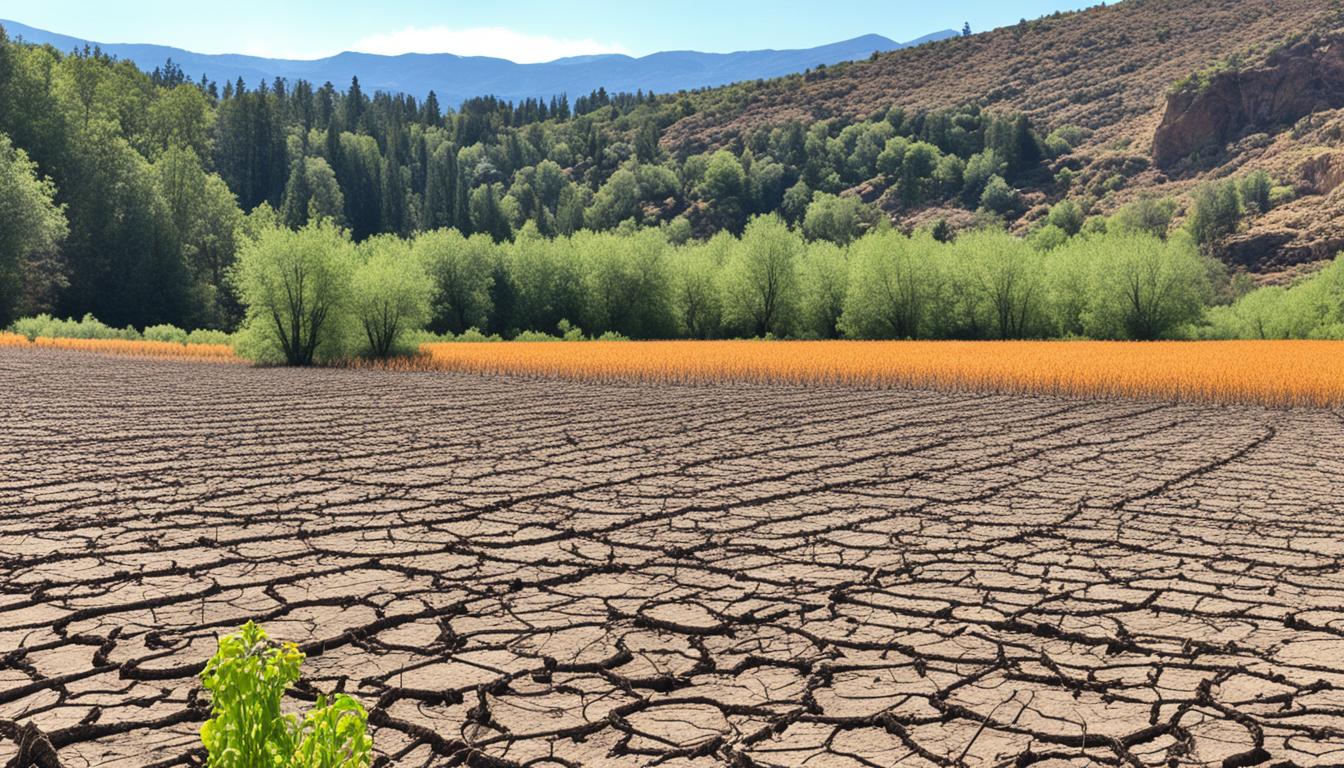
Did you know New Jersey farmers lose a lot of money every year? They face a $290 million loss from crop failures or pests. This hits hard, even with over 10,000 farms making more than $1 billion in revenue.
Recognizing the need for crop failure risk mitigation is key. This is essential for keeping farming going and the economy stable. The Schwalb family found this out in Boulder, Colorado, during the pandemic. They used a 14-day quarantine and planned for any sickness. Also, they hired skilled staff who could do many jobs. This shows how to handle emergencies well on a farm.
Being ready helps farms keep working, even at the busiest times. This means plans are ready and everything keeps going, which is vital for farming disaster recovery. Let’s see how farms can get stronger by planning for the worst.
Lance Woodbury, a DTN Farm Business Adviser, underlines the importance of preparing for crop failures. This preparation is vital for the health and growth of farms. He says it’s crucial to focus on key parts of the business like crop and finance management.
Jeff Schahczenski also highlights planning for profit in farming. A solid farm business plan guides everything from start-up to managing daily operations. It helps figure out financial needs and qualifies farms for support from the government.
Contingency planning against crop failures has many steps. It involves looking at family and business goals, resources, and setting a mission. Preparing for later years, including estate plans and investments, is as crucial as setting up ways to deal with unexpected events.
A lot of help is available for making these plans. The USDA supports new farmers, and ATTRA has guides and tools. The National Center for Appropriate Technology and others offer advice to help farms respond to crop failures sustainably.
Knowing the whole farm-to-table process helps assess risks better. This includes risks at the growing, moving, storing, and selling stages. Things like bad weather, market changes, and new laws all play a part in farm risks.
Creating plans for many problems, not just crop failures, is key. This includes scenarios like blocked roads, not enough workers, or low market sales. All involved, from farmers to officials, must work together. Checking how plans work through practice is a must to ensure they are ready when needed.
It’s vital to spot risks in farming to make food supplies safer. Things like bad weather, pests, and money issues can cause big problems. This means we need smart plans to keep our food safe.
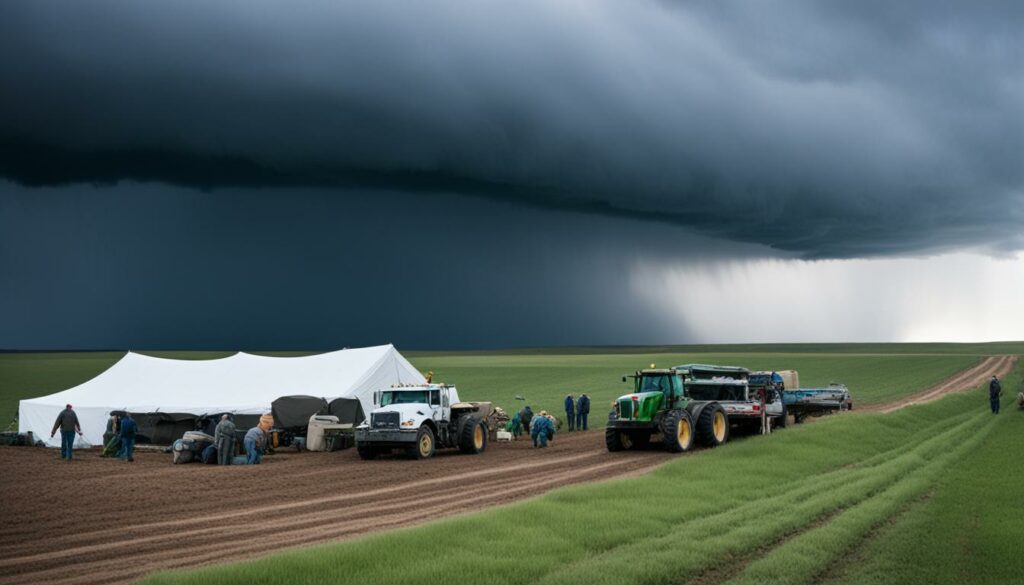
Bad weather like droughts and storms can harm our crops and our land. With climate change, the weather can be quite unpredictable. Farmers have to always be ready to change how they farm and to have plans for when things go wrong.
Pests and diseases can reduce how much food we grow and how good it is. Warm weather from climate change makes this even worse. We need to have good ways to manage pests and to check on the health of our crops. This helps us keep our food growing strong.
Changes in prices and trading rules can be tough on farmers. Acts like the CARES Act can also affect them. Farmers need plans to keep their money stable. This includes making money in different ways and making smart financial choices.
Creating a comprehensive contingency plan is vital. It helps manage crises well and keeps farms strong. Knowing what matters most on farms is key in emergencies. This helps us react quickly and well.
We use a special plan to look at what might go wrong on farms. This lets us see who needs to do what and what to do if things mess up. We check out everything from machines breaking to not enough workers.
Any good plan must look at water, check for harm, and be ready if supplies stop. Each danger needs its own special plan. This is because some problems are worse than others.
Water pollution is a big worry. Over 6,000 cases hit North Carolina by 2001’s end. We plan for the short and long haul. This way, we are ready for now and later if things get really bad.
A great agricultural continuity planning covers what’s most important, how to react, and what we have to use. It lists:
With this detail, farms can deal well with dangers.
Farms need good info like safety sheets to act right in emergencies. They also need to test and update their plans often. This is something many other industries do too.
Having a solid plan keeps farms running smoothly even when things are tough. It cuts down on losses and keeps their name good even in bad times. Good planning is the way to bounce back faster.
Creating a strong contingency plan requires tackling multiple things. It helps a farm stand strong against all sorts of problems. A great plan needs careful use of resources, understanding risks, and solid ways to talk with everyone.
Putting resources in the right place is key to this plan. It makes sure that things like staff, tools, and money are there when needed. During the planning, we look at what parts of the farm need what. Then, we make sure everything is ready for any big problem that might come our way.
Figuring out what could go wrong and how bad it could be is important. This lets farms focus on what to protect first. We study what can cause harm, what is at risk, and how to stop it from getting worse. The idea is to always look out for new dangers and make sure we are ready for them.
Talking well with everyone is critical. It ensures people know what to do if a major problem hits. Giving clear orders to the team helps keep the farm running, even during tough times. Good communication means we can act quickly and work well together, always ready for the worst.
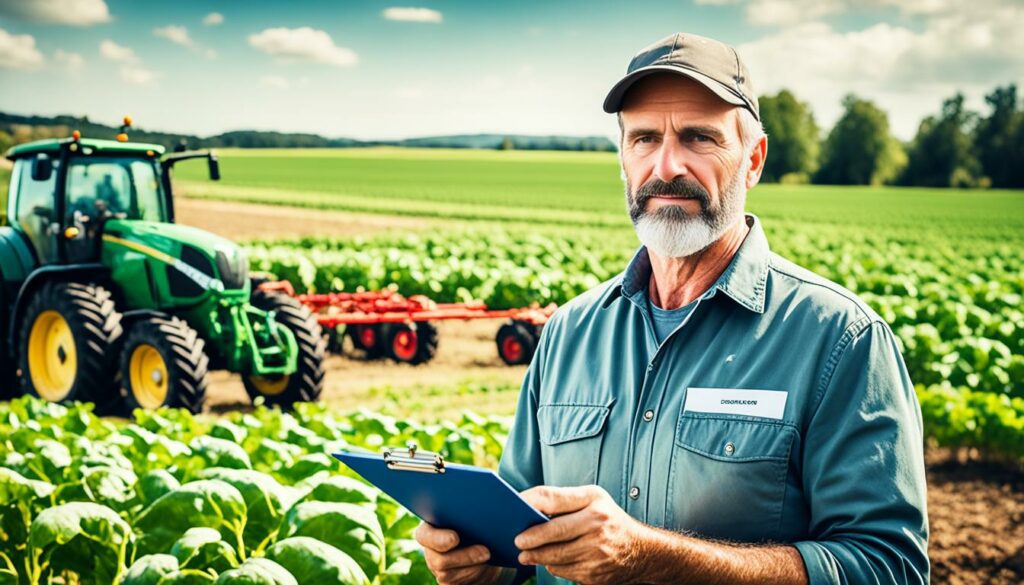
A solid plan mixes using resources smartly, understanding risks, and good communication. By doing this, farms can grow stronger, ready for anything that might come their way. It’s all about being ready for the known and unknown challenges.
Setting up early warning systems is vital for putting agricultural contingency measures in place. It helps lower the risk of crop failure. The FAO outlines five key parts for a good system. These include getting info on hazards, knowing how they impact resources, who is vulnerable, analysing early warnings, and letting everyone know.
The analytical early warning capacity is crucial. It means getting well-analysed info out quickly to those who make decisions. This info helps prepare for possible crises.
Sharing warnings is really important. They need to reach everyone who might be affected, from government bodies to NGOs. This ensures steps are taken fast when needed.
Systems that involve people, like people-centred early warning systems, are better. They include those in danger, making the response stronger and quicker.
Many groups work together to make early warnings work. This includes national and local governments, technical agencies, and NGOs. The media also helps by spreading the word.
In regions, like in Southern Africa, groups work together to warn about dangers. They team up with local communities and governments. This makes their efforts even more effective.
| Element | Description |
|---|---|
| Systematic Collection of Hazard Knowledge | Gathering data on potential hazards to build a comprehensive risk assessment framework. |
| RNR Impact Knowledge | Understanding the impact of Renewable Natural Resources under various hazard scenarios. |
| Vulnerability Knowledge | Analysing the vulnerability of communities and agricultural systems to different hazards. |
| Analytical Early Warning Capacity | Delivering analysed information promptly to decision-makers. |
| Dissemination and Communication | Ensuring warnings reach stakeholders to enable swift action. |
Getting early warning systems to work involves many partners. It needs crop failure risk mitigation and good agricultural contingency measures. This way, farming can be safer from unexpected events.
The world is seeing more natural disasters like floods, hurricanes, and droughts. This is because of climate change. This poses a big threat to farmers’ lives and can ruin their crops. It is very important for them to have plans ready for when disaster strikes to keep their farms going.
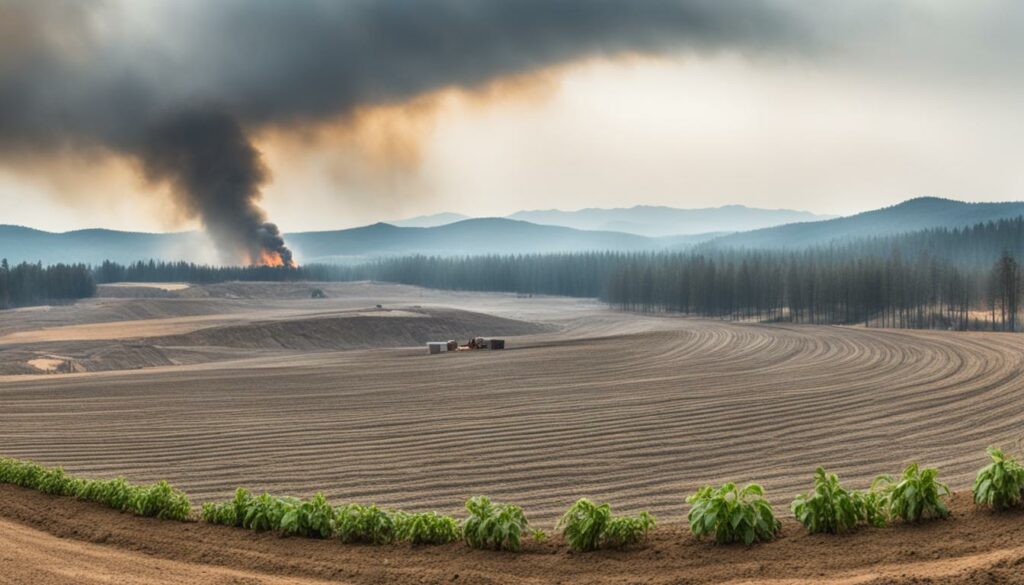
Droughts can be very hard on crops and water supply. To fight this, farmers can use techniques to save water and collect rainwater. It’s also smart to have different ways to get water and recharge the groundwater. These steps are key to surviving a drought.
To handle floods, you must know how they happen and stop them if you can. Making things like levees and dams can protect your farm from getting ruined. You should also build your farm buildings higher up. Using crops that can handle floods is also a good idea. Having good ways to know when a flood is coming helps you get ready, keeping damage low.
Frost and hail can destroy farms. Farmers can use things like windbreaks, frost cloths, and nets to stop or lessen this damage. Making plans to quickly protect or leave the area in these situations is also crucial. Always update these plans with the newest weather warnings for the best protection.
Looking at past disasters can show us how to prepare better. By getting ready and knowing what to do when disaster hits, farmers can bounce back quicker.
| Disaster Type | Preparedness Strategies |
|---|---|
| Drought | Water conservation, alternative sourcing |
| Flood | Flood patterns, control systems |
| Frost/Hailstorm | Windbreaks, frost cloths, hail nets |
Combating pest and disease outbreaks is crucial for agriculture’s health and sustainability. Monitoring crops closely and acting fast when problems are found is key. This approach helps stop damage, keeping the crop healthy and productive.
Using Integrated Pest Management (IPM) is a smart tactic. It mixes different methods like using pesticides carefully, natural control, and farming techniques. For example, ploughing, crop rotation, and keeping equipment clean can lower pest numbers by making their life difficult.
Fitting physical barriers, like nets, in greenhouses can protect crops from bugs. Also, letting natural enemies loose can help control pests in places like orchards.
Getting the right information is crucial for managing risks well. Farmers use many sources, like farm records and advice from experts, to make good decisions. Extension workers are very helpful in teaching farmers the best ways to handle risks and make choices.
The best use of pesticides is as part of a bigger plan, like an IPM program. This method, along with careful monitoring and adjusting strategies, leads to long-lasting results. It helps keep pests low without harming the environment or people.
Today’s farmers deal with many more risks, from unpredictable weather to global market changes. Staying on top of these challenges is important for food security and the health of our farms. It’s all about managing these risks well to keep our food and farms safe.
Crop insurance is crucial for managing the risks in farming. It offers financial help to farmers if their crops face problems. This includes things like natural disasters, pest outbreaks, and changing market prices. By protecting them from these dangers, crop insurance supports the safety of our food supply.
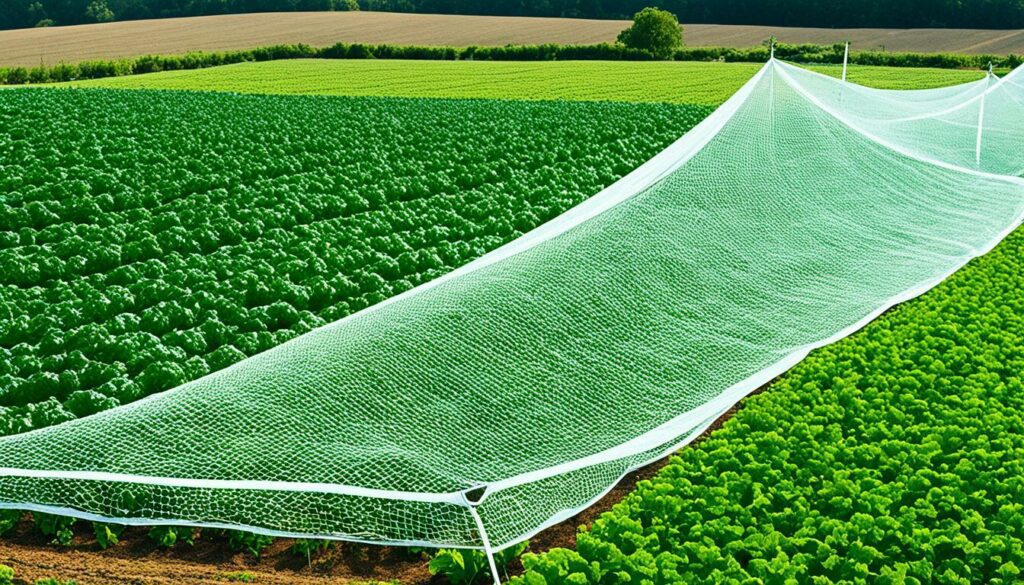
In the United States, the Federal Crop Insurance program protects over 100 crops. It shows how varied and risky farming can be. Thanks to the 2018 Farm Bill, there are now stronger policies. These include the Whole Farm Revenue Protection. It helps farmers better manage their risks and stay productive.
Farmers can choose from different types of crop insurance. Each is made for a different part of farming and risk. You have policies that protect how much you grow, how much you make, or your entire farm. They can help cover losses from bad weather, floods, or bugs.
Crop insurance helps farmers stay financially secure. It lets them recover from bad seasons and keep going. This is key for a steady food supply. But, it does have its limits. It might not cover everything you lose, and it can be costly. Farmers need to balance the good it does with its downsides.
Choosing the right insurance is important. It needs careful thinking about your farm, the risks you face, and what you can afford. Think about the biggest dangers in your area. Also, consider the support available, like the Coronavirus Food Assistance Program (CFAP). This extra help for tough times makes picking the right policy even more vital.
For more detailed crop insurance information, check out the National Agricultural Law Center. It’s a great place to learn about your options.
Agricultural diversification helps farmers deal with market and weather uncertainties. They grow many types of crops or mix in livestock. This reduces risk and makes their income more stable. It also lessens the chance of losing out on money from a single product.
Diversification in farming brings many benefits. For example, sowing small grains before row crops allows farmers to harvest two crops in a year. This not only uses the land better but also ensures steady crop yields. This is vital for food security in tough seasons.
Adding legumes to the mix boosts soil health. It does this by upping nitrogen and increasing organic materials. Livestock, when combined with crops, cuts down on the need for store-bought fertilisers. This step also improves the soil. Good soil health is key for long-term farming success.
Farmers can also use extra machinery to earn more. This is through offering machine services to others. And by locking in better prices for some of their produce ahead of time, or by selling directly to customers, they make their financial situation stronger.
| Practice | Benefit |
|---|---|
| Planting small grains before row crops | Produces two crops on the same land within a year |
| Adding a legume crop | Raises nitrogen levels and increases soil organic matter |
| Incorporating livestock | Reduces need for purchased fertilisers and increases soil organic matter |
| Offering custom hire services | Increases income and profits |
| Forward contracting and direct marketing | Benefits from higher prices and diversifies income sources |
| Insuring crops, livestock, or revenue | Mitigates risks by transferring them to an insurance provider |
Diversifying makes sure farms can handle problems, keep cash flowing, and use their resources well. Insuring parts of the farm can lower some risks, too. These steps secure a farm’s future and keep it strong.
Looking at how drought strategies worked shows us the power of planning ahead. This is clear when we see real success stories.
In Kenya, Uganda, and Ethiopia, drought hit hard. It caused big problems for farming. In places like Utah and Wyoming, ranchers faced tough times because of less rain and hotter days.
Farmers didn’t always use the information that could help them from places like the National Weather Service. Even though this data could make a big difference, its use was not popular.
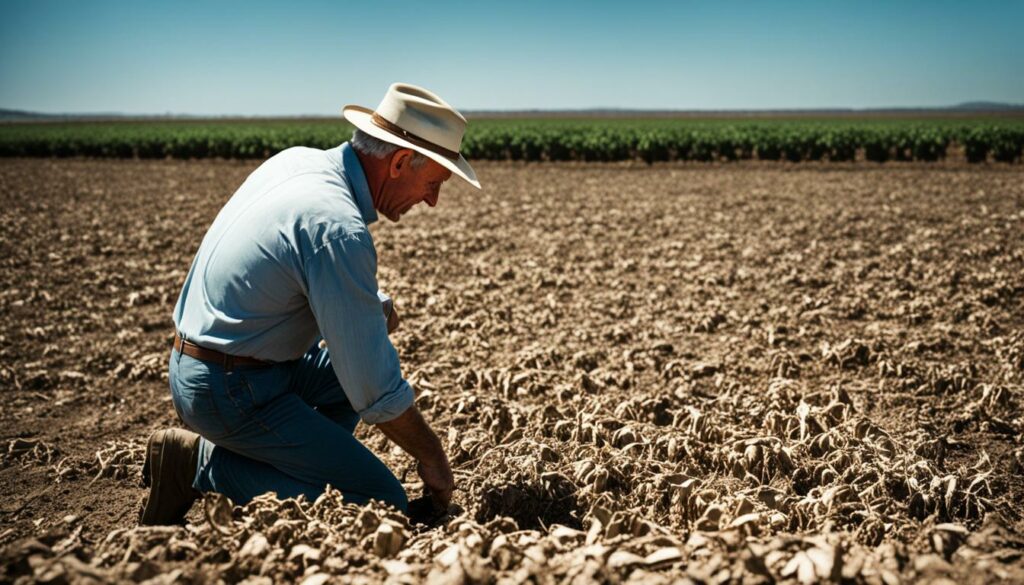
States like Utah and Wyoming made plans to manage drought well. About 60% of cattle farmers there had plans in place. These plans included using:
So, how did these strategies work? They showed us a few key points:
A study in Rangeland Ecology & Management stressed the need for teamwork. Big farms worked better on drought issues when they joined forces. This shows that working together can build a stronger response to drought.
| Study Area | Key Strategies | Noteworthy Outcomes |
|---|---|---|
| Utah and Wyoming | Drought-resistant crops, improved irrigation | Perceived improvement in outcomes, better adaptive capacity |
| Kenya, Uganda, Ethiopia | Climate monitoring, early warning systems | Increased coordination, enhanced planning |
This study on drought planning underlines how good plans can save farming. Planning is key to bouncing back from disasters. It’s crucial that farmers and those in agriculture keep finding better ways to face droughts.
Community and government help are crucial in preparing for crop problems. They offer support that helps farmers stay productive during hard times. This includes aid for those who raise animals and grow crops.
| Program | Purpose |
|---|---|
| Livestock Forage Disaster Program (LFP) | Compensates eligible livestock producers for grazing losses due to drought or fire on specific types of land. |
| Livestock Indemnity Program (LIP) | Offers benefits for livestock deaths exceeding normal mortality due to adverse weather or animal attacks. |
| Emergency Assistance for Livestock, Honeybees, and Farm-Raised Fish (ELAP) | Provides emergency assistance for losses due to various conditions not covered under other programs. |
| Emergency Livestock Relief Program (ELRP) | Offers relief payments to livestock producers for forage losses due to severe drought or wildfire. |
| Emergency Loan Program | Provides loans to assist producers in recovering from various natural disasters. |
| Disaster Set-Aside Program | Allows for moving loan payments to the end of the loan term for producers with existing direct loans who are unable to make scheduled payments. |
| Noninsured Disaster Assistance Program (NAP) | Compensates producers of noninsurable crops for losses due to natural disasters. |
| Tree Assistance Program (TAP) | Provides financial aid to orchardists and nursery tree growers for damaged trees, bushes, and vines due to natural disasters. |
| Emergency Conservation Program (ECP) and Emergency Forest Restoration Program (EFRP) | Help repair farmland and restore forest health after natural disasters. |
They also share important information like fact sheets and tools online. The USDA provides these to give farmers expert advice and updates. This helps them get ready for and tackle problems smoothly.
The government is focused on helping agriculture deal with climate changes. The USDA is working closely with the Biden-Harris Administration to adapt and be sustainable. This shows how crucial government help is for farmers.
With both local and national help, farmers can face difficulties and come out stronger. This joined-up approach ensures farmers can weather any storm and keep growing.
Building a firm financial base in farming is key. It protects against sudden money troubles, like those from droughts. Areas at a high risk of drought may see them often. Every 2 or 3 years, they might face severe droughts. This is more frequent than in places that are not at high risk. So, getting ready for emergencies and making your finances strong are crucial for farmers. This keeps their work stable, even when nature is hard on them.
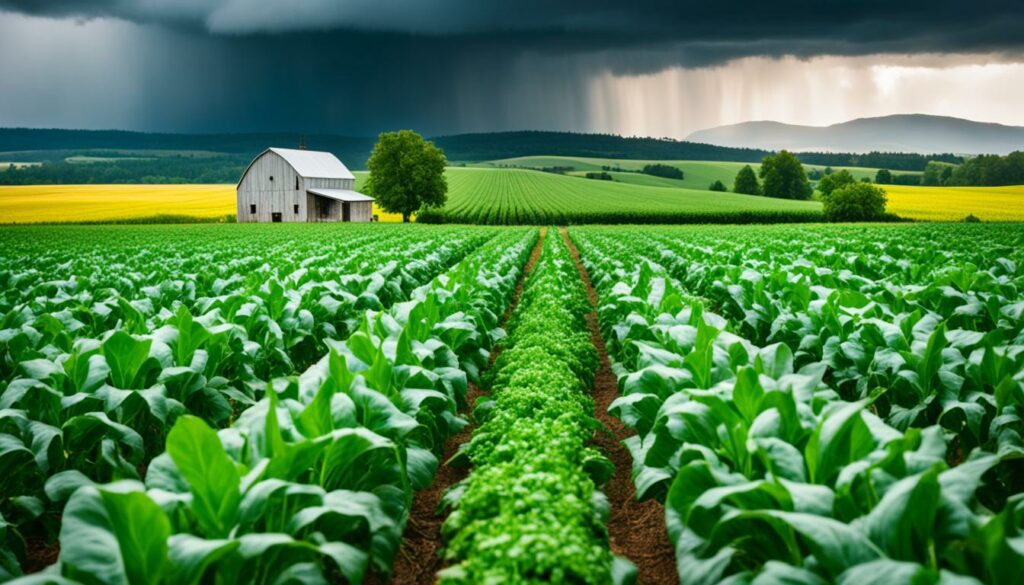
Holding money back for emergencies is vital in farming. It acts as a lifeline when bad times hit, like extended droughts. In 2012, over two-thirds of U.S. counties faced droughts serious enough to be declared as disaster areas. This shows how important it is to be ready financially. Such funds help cover daily costs and unexpected bills. They make it possible to react fast and well when faced with emergencies.
Getting grants and subsidies improves a farmer’s money stability. These help cope with the threats of climate change and other challenges. Such help lessens the cost of upgrading things like irrigation. This can make farms more resilient to drought. Laws on water use also matter a lot, especially in areas prone to droughts.
Smart financial planning is a must for farming to thrive despite risks. This means creating detailed plans that look at things like how the market changes during droughts. It’s crucial to plan for issues that could harm the land, like too much water taken out of the ground. Laws in places like California show the push for farming to be more sustainable. The USDA is also working hard to help with these plans in response to government orders. Financial planning that’s always adapting is needed to face challenges head-on.
Modern farming is complex and needs strong strategies. Input from agricultural experts and advisory boards is key. Their deep knowledge helps in detailed planning and executing backup plans.
The FAO/WHO’s advice on food safety highlights the importance of expert views. It encourages everyone to learn from its advice. This approach aims to make better decisions in the food sector.
Organisations like JECFA and others play a big role. They ensure quality data that helps advisory boards give solid advice. This way, farmland and crops can be managed well.
Talking to experts brings valuable insights. It covers risk, planning, and how to respond in emergencies. This service is crucial when dealing with pests, disasters, or other threats. They offer clear, exact advice.
Sharing expert talks through reports and news is vital. It keeps everyone informed for a united agricultural response. The system aims to improve expert abilities, looking towards a better future.
Using advisory boards and expert advice helps farmers be ready for crises. By making these resources part of their plan, they can protect their work better. This leads to stronger, more stable farming.
Effective agriculture risk management starts with consistent contingency planning. This method helps farmers face unexpected challenges. It’s important to set clear goals and priorities. This way, they know what needs attention the most in their farming.
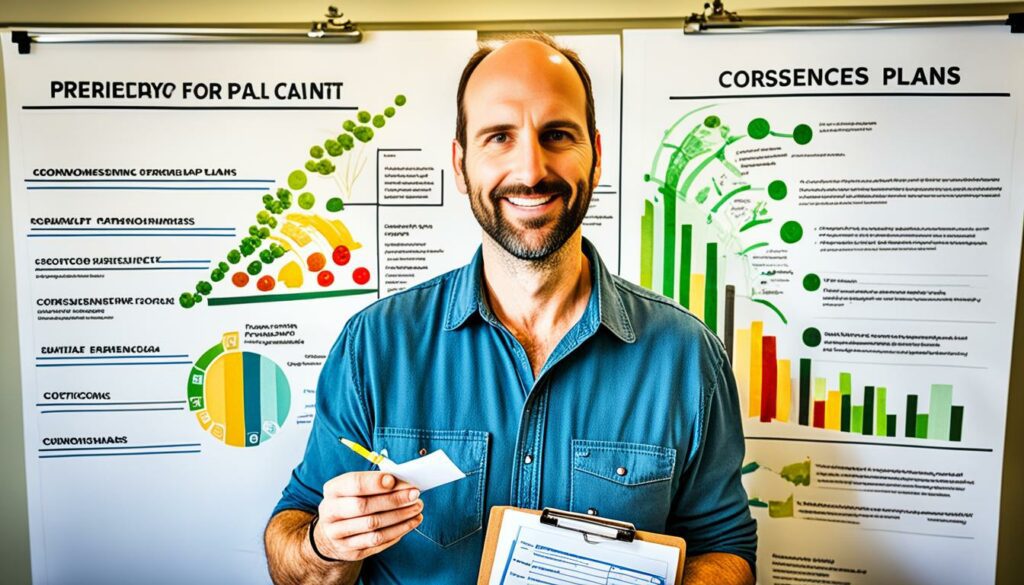
For good contingency planning, farmers must know what’s most important. They should figure out the main tasks and risks. This helps them use their resources wisely. With such planning, the EU achieved a net trade surplus of EUR 62 billion in 2020. This shows how vital good planning is in farming.
It’s key to have detailed plans written down and shared. Everyone involved should know their roles. During COVID-19, 54% of people said clear guidelines made a difference. They helped keep the flow of goods steady. This highlights the value of clear plans in managing risks.
Plans must be checked and updated often to stay useful. Farming and the world around it change quickly. The CAP reform works to keep farming smart and adaptable. By keeping their strategies fresh, farmers can deal with risks better.
The agricultural sector shows great resilience against crop failures. This is thanks to strong planning and risk assessment. From growing to selling, it’s key to understand and deal with risks. Things like bad weather, changing markets, and new rules need serious thought to get ready for any loss.
It’s crucial to have plans ready for different problems. Farmers should be ready for any crop issues or problems moving goods. Working with others like suppliers and the government makes these plans stronger. It’s also important to test how well these plans work before a real crisis hits.
In places like Bihar, we’ve learnt a lot about farming during different rain seasons. Areas that often face droughts or floods can do a lot to adjust. Picking the right crops, managing rainwater, and using land in smart ways can help a lot. This shows how important it is to have special plans for each area’s farming challenges.
Good planning and managing risks are at the heart of dealing with crop loss. By always improving these methods and working closely with others, farmers can be ready for major changes. Doing so protects not just their farms, but also helps keep food stable and sustainable for everyone.
Contingency planning for crop failures is getting ready for the unexpected in farming. Farmers plan for risks like natural disasters and market changes. They ensure their farms can bounce back fast from setbacks.
To reduce crop failure risk, plan ahead. This means assessing risks, setting up alerts, and putting resources in place. Be ready for things like natural disasters and changes in the market.
The key parts are figuring out what you need, knowing the risks, and how to talk about them. Add in ways to watch out for trouble early and respond fast in emergencies.
Spotting risks helps farmers get ready for bad times. They can plan for things like storms and crop diseases. This helps keep their crop safe.
Early warnings catch issues like pests before they get bad. This helps farmers act quickly to protect their crops. It’s like a heads-up to avoid trouble.
To protect against droughts, save water. Use flood systems for too much rain. And shield crops from bad weather, like frost. These steps make your farm tougher.
Crop insurance helps cover losses from various risks. Choosing the right policy helps a farm recover from failure. This keeps their business going.
Different crops or livestock mean not risking everything on one. It keeps income steadier and the farm more stable against change. Plus, it’s better for the environment.
One story is about using crops that can handle dry spells. Also, better watering and saving water helped. These steps kept the farm producing well even in a drought.
Community and government help with advice, money, and training. These boost a farmer’s ability to plan and recover from problems. They keep the farm running smoothly.
Keep extra money, use grants, and make good financial plans. This helps your farm stay strong in tough times. You can keep growing even when things go wrong.
Experts bring new ideas and know-how to planning. Working with them can make your plan better. They help deal with the challenges of farming today.
Goals and plans keep your risk management focused. They make sure everyone knows what to do. Regular checks help keep your plan working well and updated.